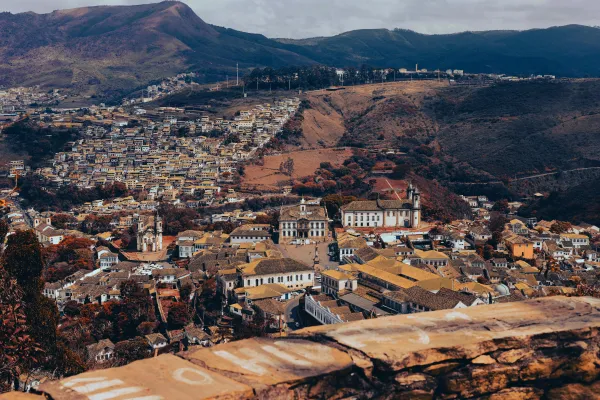20 Best Waterfalls In Indiana (Including Hiking Trails)
Indiana holds secrets far older than its cities and farmland suggest. Beneath its wooded hollows and rocky ravines flow waters shaped by time, pressure, and earth’s quiet persistence. The state’s waterfalls are not only beautiful—they are ancient records of a land sculpted by glacial retreat, prehistoric seas, and millions of years of erosion. Some cascade over limestone formed when Indiana lay beneath a shallow tropical ocean more than 350 million years ago. Others spill into gorges carved by the meltwaters of vanished ice sheets that once covered the Midwest.
These falls, some barely trickles in summer and thunderous in spring, offer more than a scenic view. They form where layers of resistant rock cap softer stone, creating natural ledges that split rivers and creeks into ribbons of sound and mist. Fossils of crinoids and trilobites are often found in the rocks nearby, revealing the aquatic life that once thrived in these same regions before the first trees took root.
For generations, these waterfalls have served as gathering places, sources of inspiration, and markers of natural resilience.
1. Anderson Falls
In a quiet nature preserve in Bartholomew County, water flows over a wide limestone ledge, forming a curtain-like waterfall that reflects the layered history beneath it. Anderson Falls drops about 12 feet, but its horizontal spread of nearly 100 feet makes it visually striking. The rock that forms this ledge belongs to the Louisville Limestone and Waldron Shale formations—sedimentary layers deposited more than 400 million years ago when Indiana was part of a vast, shallow sea.
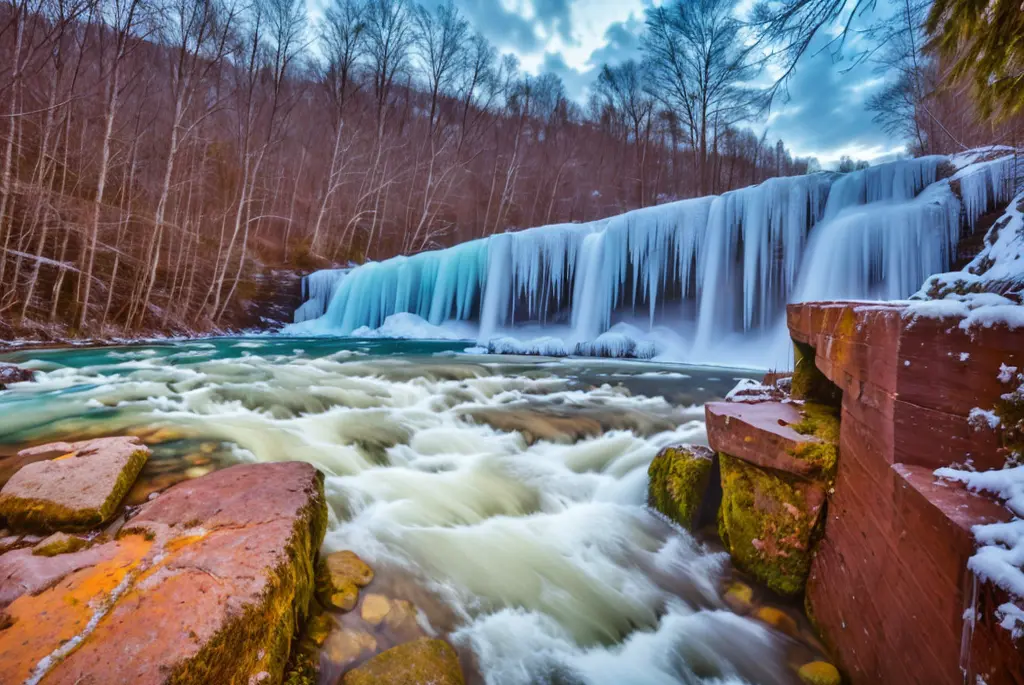
This waterfall is surrounded by a 44-acre preserve, protected for its ecological diversity and rare glimpse into the region’s ancient past. Visitors will find seasonal wildflowers, sycamores, and trails that loop through hardwood forest. The area is also known for its bird population, including woodpeckers, warblers, and the occasional great blue heron wading below the falls.
Anderson Falls became a designated nature preserve in the early 2000s, and it is managed to ensure both public access and environmental preservation. It is not a high waterfall, but it draws visitors for its tranquility, photogenic qualities, and clear link between geology and ecology. The sound of falling water here is steady, shaped by a landscape still holding the outlines of the world long before us.
2. Clifty Falls
On the edge of the Ohio River valley, a deep canyon cuts through ancient bedrock where time seems carved into every wall and crevice. The cliffs here expose layers from the Mississippian period, particularly the Saluda and Borden formations—limestones and shales deposited over 350 million years ago. These formations are what create the dramatic vertical drops and ledges that give rise to the waterfalls in this park.
Water volume varies wildly throughout the year. In spring, snowmelt and rain create roaring sheets that crash into rock basins far below. By midsummer, many falls reduce to thin veils or vanish into mist. This seasonal transformation reveals fossil-laden rock, including preserved corals, crinoids, and shells—reminders that this land was once submerged beneath ancient seas.
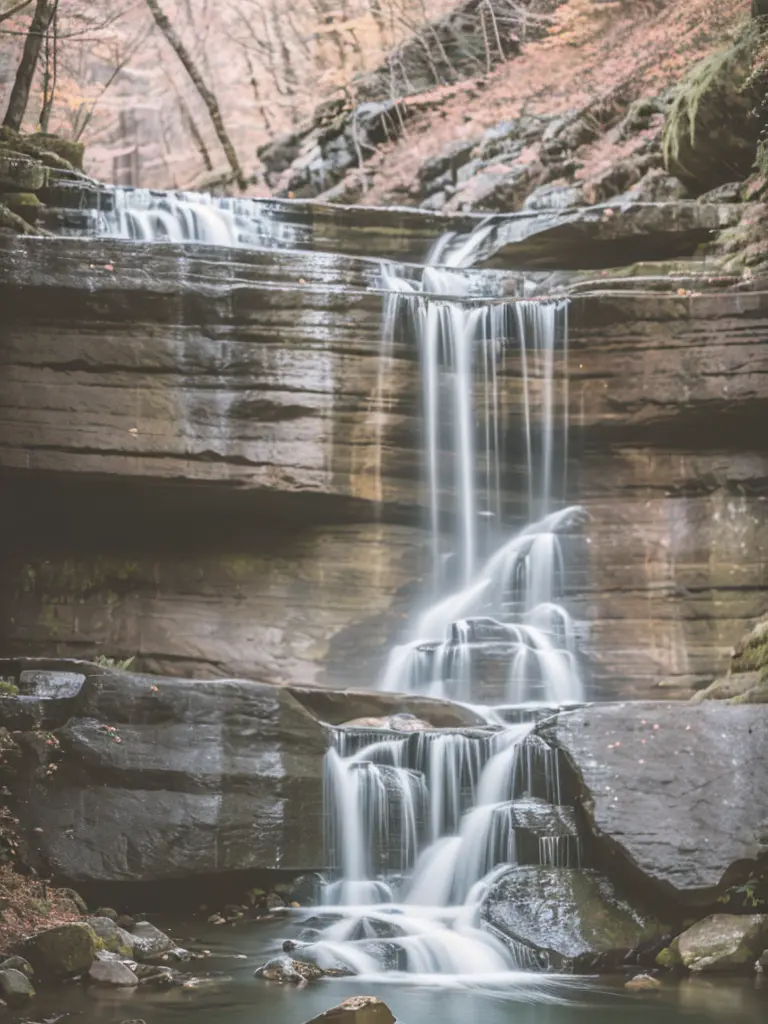
This area became protected in the early 20th century as part of Indiana’s efforts to preserve its geological heritage. The trails that wind through the canyon offer steep climbs, shaded overlooks, and echoing views of plunging water and layered cliffs. The waterfalls here are not only about movement—they are about time: slow, patient, and impossibly old.
3. Big Clifty Falls
Big Clifty Falls is one of the tallest waterfalls in southern Indiana, with a drop of around 60 feet. It’s formed where a stream flows over strong layers of Mississippian limestone and plunges into a deep gorge below. The cliff face shows stacked rock layers that date back hundreds of millions of years, each one telling part of the region’s long geological story.
During spring rains, the waterfall is loud and powerful. In drier months, it narrows to a stream but still keeps its shape and height. Visitors often hike to the overlook above or descend into the canyon for a view from below, where the sound of falling water bounces between rock walls.

Big Clifty Falls is part of a system of four main waterfalls in its area, each shaped by the same ancient erosion and shifting land. It stands out for its size and for the way light hits the spray as it falls. Even when the stream runs low, the exposed rock behind it remains impressive—a reminder that water carved this canyon, layer by layer, over countless years.
4. Little Clifty Falls
Little Clifty Falls might be smaller than its neighboring drop, but it has its own appeal. This waterfall flows through a shaded ravine, cutting over the same limestone layers as its larger counterpart. With a height of about 30 feet, it’s gentler in flow and often more approachable, especially during dry seasons when the stream narrows into a soft trickle over smooth rock shelves.
What makes Little Clifty special is its setting. Moss grows on the stone around it, and the trail leading to it winds through dense trees and quiet groves. You can hear the falls before you see them—just a steady rush tucked within the woods. The air feels cooler here, and the water pools into a shallow stream that continues through the gorge.
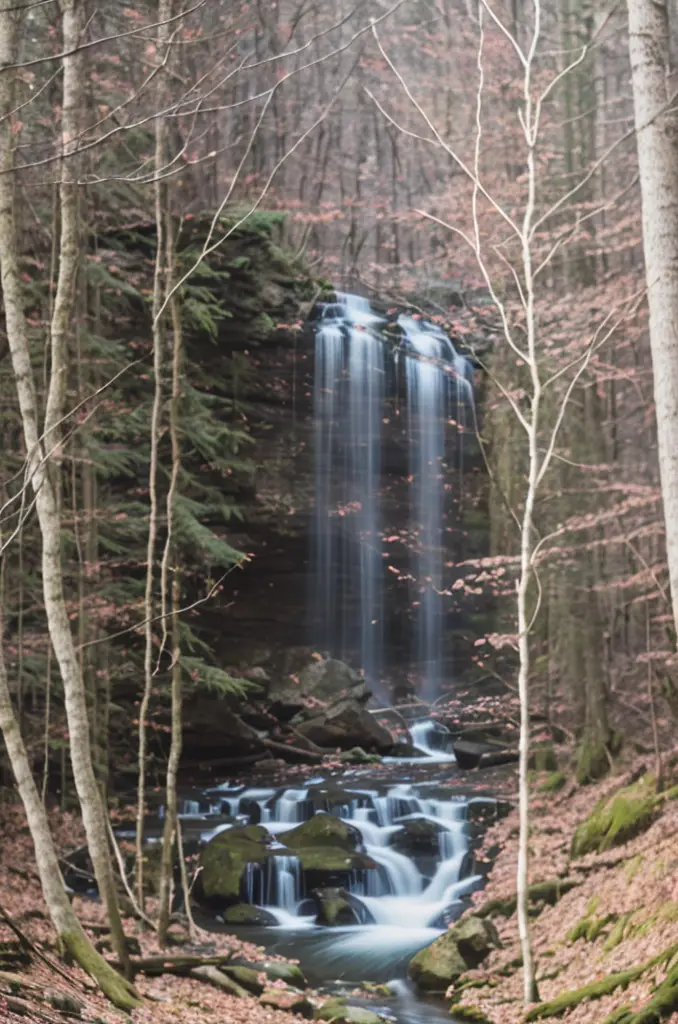
Even though it’s smaller, Little Clifty still reveals millions of years of history in its cliff face. Fossilized sea creatures can sometimes be spotted in the rock, especially after rainfall. It’s a peaceful spot that feels like a quiet corner of something much bigger—perfect for hikers who want both beauty and stillness.
5. Calli Nature Preserve - Rock Rest Falls
At the edge of LaGrange County, Rock Rest Falls flows through a little-known nature preserve rich in biodiversity and geologic charm. The water spills over a ledge of shale and limestone into a shallow pool below. Though the drop is modest, around 10 to 12 feet, the setting makes it memorable—thick woods surround the stream, and the rock beneath your feet holds stories from a time when this part of Indiana was under a prehistoric sea.
The preserve covers over 80 acres and includes several trails, wildflower meadows, and dense forest. In spring, the trail to the falls is lined with trilliums, trout lilies, and mayapples. Birdsong follows you as you walk, especially early in the morning when the forest is just waking up.
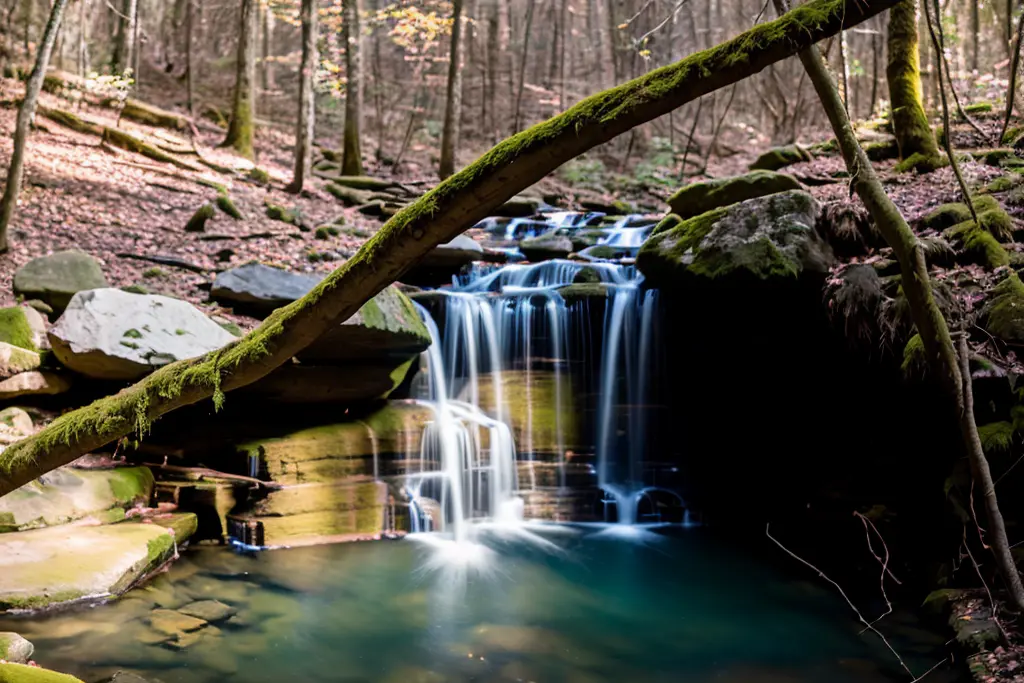
The waterfall itself is tucked within a slope, and while it’s not powerful, the sound it makes in quiet weather is steady and calming. It’s a great spot for nature walks, journaling, or simply pausing for a moment off the trail. For those who appreciate subtle beauty and layered natural history, Rock Rest Falls is a quiet standout.
6. Rock Rest Falls
This waterfall shares its name with the Calli Nature Preserve but stands as its own experience. Rock Rest Falls is formed by a slow-moving stream cutting over ledges of shale, shaped by both glacial runoff and rainwater carving through layers of soft rock. The water doesn’t fall in a dramatic drop but flows in sheets down gently sloped rock, creating a wide, tiered surface that glistens after rain.
What makes this site special is the texture of the rock. The exposed shale forms horizontal patterns that look like pages in a book—each layer recording a different chapter in the earth’s past. Some surfaces are smooth from centuries of erosion, while others break easily underfoot, revealing tiny marine fossils.
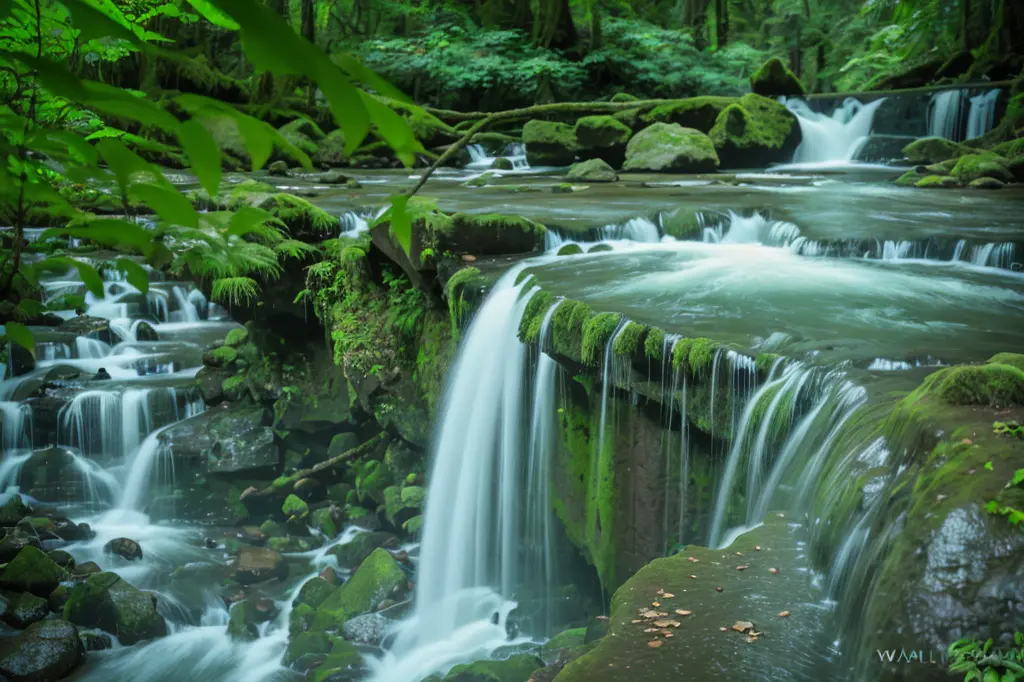
The surrounding woods are quiet and mostly untouched, creating a natural amphitheater for the soft movement of water. This is a place for close looking: the way moss clings to the edge of the rocks, the changing color of water in different light, the birds and insects that thrive near the spray. Rock Rest Falls may not roar, but it speaks in details—and rewards the kind of visitor who listens carefully.
7. Cataract Falls
Cataract Falls holds the title of Indiana’s largest waterfall by volume. Located along Mill Creek, it consists of two main drops—an upper falls and a lower falls—spaced about half a mile apart. Together, they create a combined vertical drop of 86 feet, with the upper section plunging around 45 feet and the lower about 40 feet. The volume of water here is especially powerful in spring and after heavy rains, when the creek swells and the roar of the falls can be heard from the nearby trails.
The rock formations at Cataract are part of the Mansfield Sandstone group, dating back to the Pennsylvanian period over 300 million years ago. These layered rocks were shaped by the movement of glaciers, which deepened the valley and left behind the terrain that channels water into such a strong flow today.

Visitors reach the falls through a well-maintained trail system within Lieber State Recreation Area. Stone outcroppings and natural pools make this a favorite spot for photographers, families, and geology buffs. The area is also known for its old covered bridge just downstream, adding a historical touch to an already dramatic setting.
8. Cascades Park Trail
Cascades Park offers a different kind of waterfall experience—less vertical plunge, more steady motion across rock. Located near Bloomington, this park features a series of small, continuous cascades that flow over a limestone creek bed. The falls are gentle but constant, creating a rhythmic pattern of sound as the water slips over each ledge.
The stone here is part of the Harrodsburg Limestone, a formation common in southern Indiana and rich in fossil history. Though the falls themselves are not tall, they follow a natural slope that was likely shaped by thousands of years of erosion and water pressure. Rain increases the water flow dramatically, turning the peaceful trickles into miniature torrents that glide through the wooded valley.
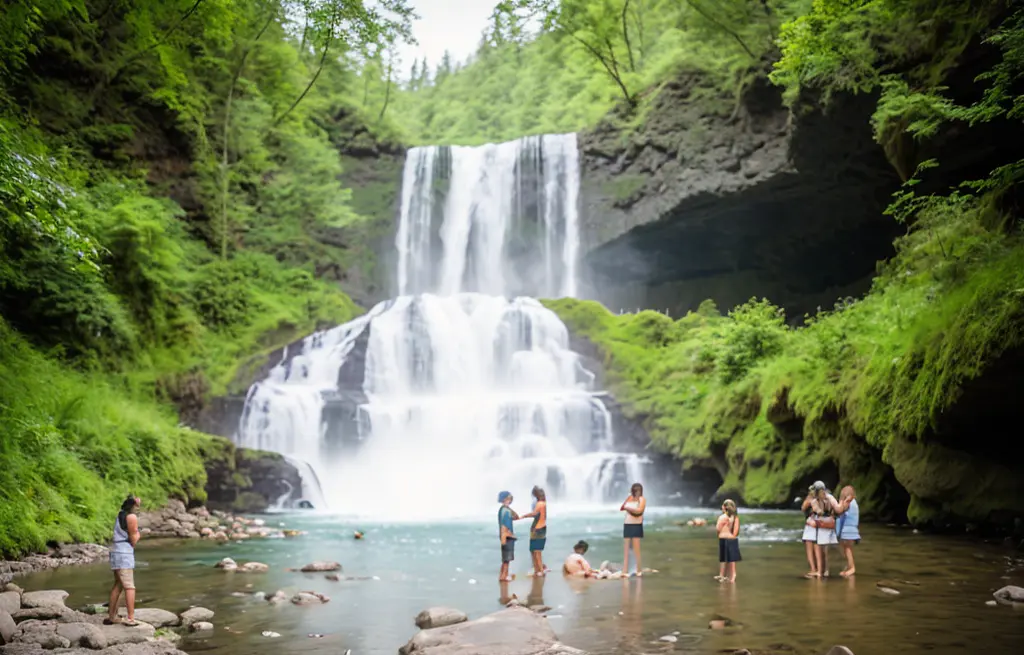
Cascades Park Trail is a popular local walking path. Families come here to picnic, kids play in the shallows, and photographers often capture the soft motion of water over smooth stone. The trail is paved and easy to navigate, making it one of the more accessible waterfall areas in the state. It may not feel wild or remote, but it offers a peaceful, grounded connection to water and time.
9. Deadman Falls
Deadman Falls lies hidden within a rugged ravine, accessible only to those willing to follow an unmarked path into one of Indiana’s more mysterious natural areas. The name alone sparks curiosity, though the origin is unclear—perhaps tied to local folklore or the steep, sometimes treacherous terrain that surrounds it. The waterfall itself drops about 25 to 30 feet, depending on the season, with water spilling over layers of sandstone into a shaded pool below.
What makes Deadman Falls especially compelling is its wildness. The surrounding rock is part of the Borden Formation, known for its greenish shale and fossil-rich layers. In the spring and after rainfall, the gorge can echo with the sound of the falls and rushing water below. Erosion has carved small ledges and pockets into the stone, and sharp turns in the creek bed give the site a natural amphitheater feel.
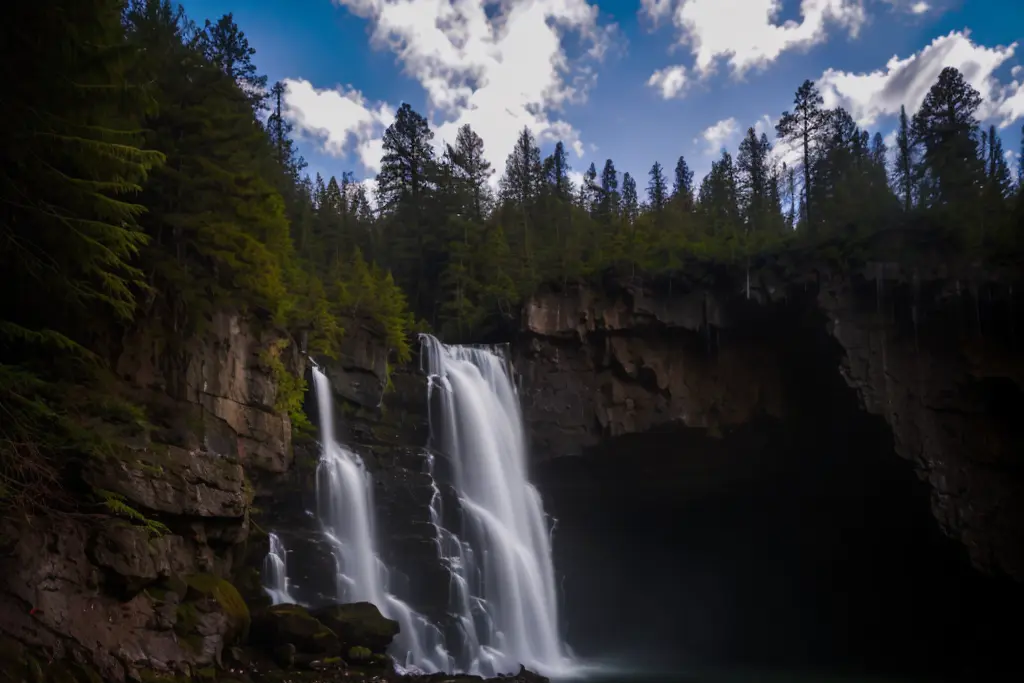
Reaching the falls often requires bushwhacking or following faint deer trails. This is not a polished park stop—it’s for those looking to explore a little deeper, both physically and mentally. It’s a place where water, rock, and time meet without signs or fences, and where nature shows its rawer, quieter side.
10. France Park Waterfalls
France Park near Logansport offers a mix of adventure and quiet scenery, and its waterfall adds a dramatic touch to a park shaped by both natural and industrial history. The falls are located within an old quarry site that once supplied limestone for regional construction projects. When the quarry was abandoned, groundwater and rainfall gradually filled the space, creating a spring-fed lake and a cliffside where water now spills down.
The waterfall here is not tall—usually under 20 feet—but its setting makes it special. Water drops over the edge of an old quarry wall into a deep blue pool below. In sunlight, the contrast between white spray and the lake’s vibrant color is striking. The water runs clear and cold year-round, fed by underground springs that seep through the limestone layers.
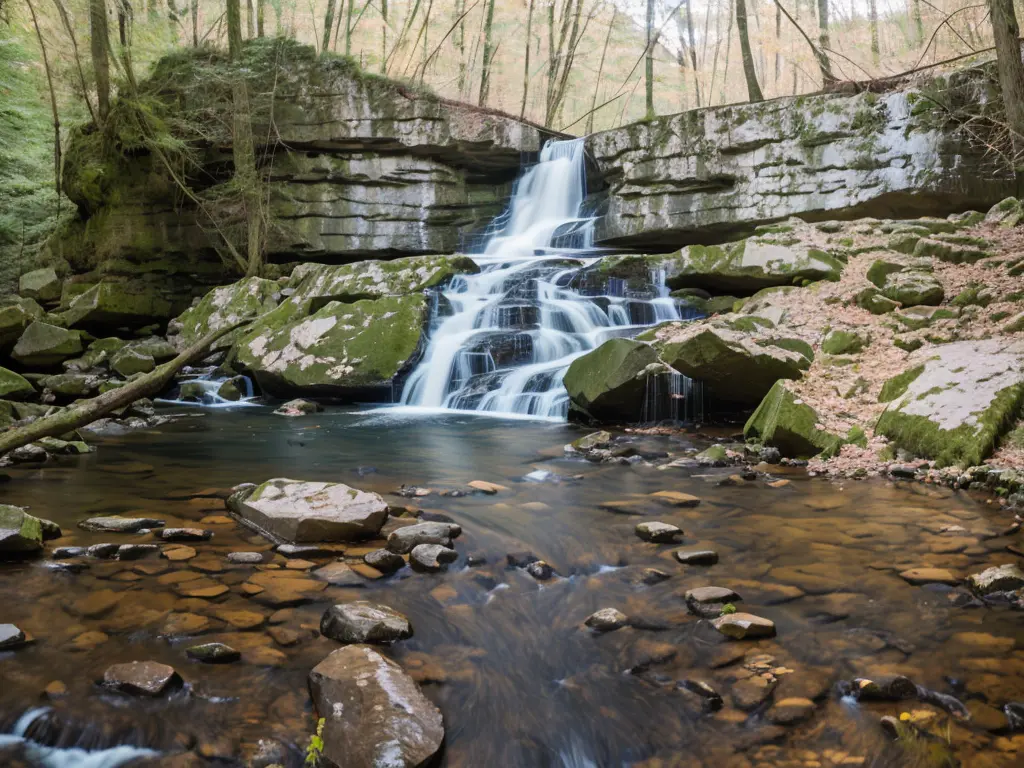
France Park offers camping, scuba diving, and hiking, so the waterfall is part of a larger outdoor experience. Visitors often stop by after swimming or walking the trails, drawn by the sound of water and the vertical face of stone behind it. It’s a place where industry and nature have blended over time, creating something new out of what was once a place of extraction and labor.
11. Hathaway Preserve at Ross Run
Hathaway Preserve at Ross Run feels like a pocket of untouched wilderness in northern Indiana. It covers over 70 acres of protected land and features a striking gorge cut through limestone and shale. The small waterfall here spills gently over rock ledges into a narrow creek that winds through the preserve, making its way past ferns, mosses, and shaded rock walls.
The preserve is managed by ACRES Land Trust, which protects areas of high ecological and geological value. The trail to the falls leads hikers through open meadows and into a wooded ravine where the air cools and sound begins to echo. While the waterfall itself is not large—more of a steady descent than a sheer drop—the surrounding cliffs add to the atmosphere, giving the space a hidden, almost secret feel.

Fossils are embedded in the streambed rock, and visitors are asked to look, not collect, as the area is considered a living classroom. Hathaway Preserve isn’t loud or grand, but it holds a quiet presence, perfect for slow walks, nature study, or time spent listening to the creek as it moves over stone.
12. Hemlock Cliffs - Hoosier National Forest
Hemlock Cliffs is one of the most dramatic natural areas in Indiana. Located in the Hoosier National Forest, this box canyon features sandstone cliffs that rise sharply around a cool, shaded trail. Waterfalls here appear after rainfall, flowing from the top of the canyon walls in narrow streams that spill onto boulders below. In spring and early summer, multiple falls may be active at once, some trickling down moss-covered stone, others dropping in clear vertical streams.
The cliffs themselves are made from sandstone deposited during the Pennsylvanian period, more than 300 million years ago. Erosion from wind and water carved the high walls and overhangs, creating shelter-like rock formations that once attracted Indigenous people to this area for protection and ceremony.
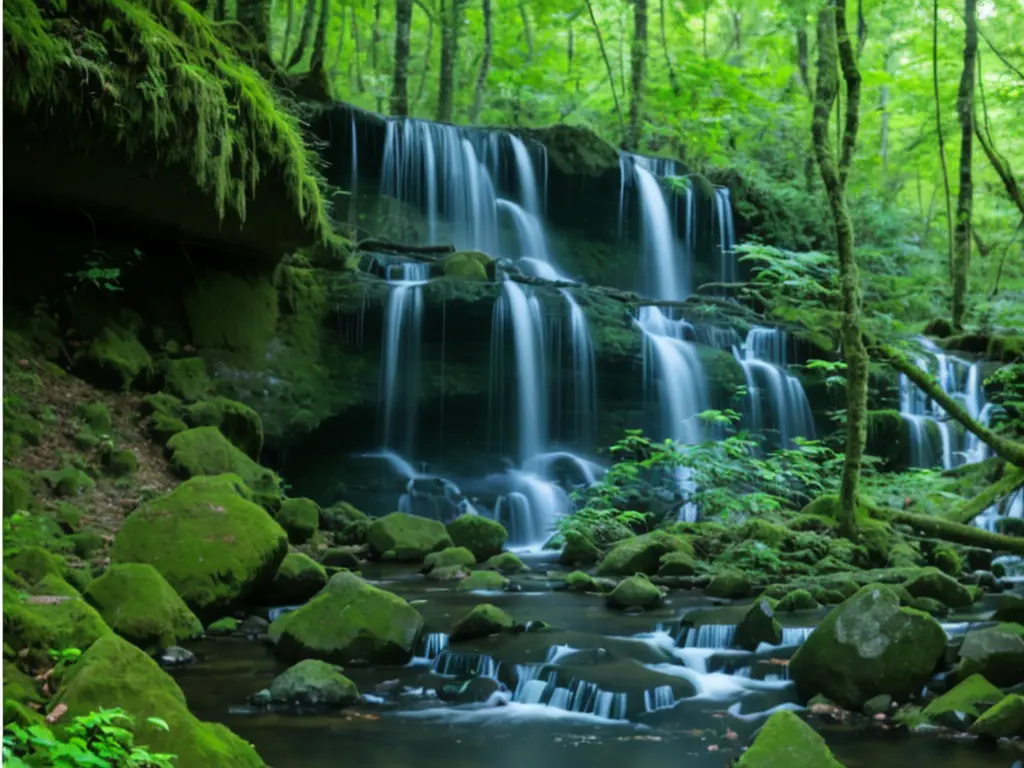
The name “Hemlock” refers to the Eastern Hemlock trees that grow here—rare in Indiana and left behind from a cooler climate thousands of years ago. The trail is a 1.2-mile loop that winds through forest and rock, offering quiet moments to stop, listen, and watch water move across stone that has been shaped by countless seasons.
This is a place where water and time have left deep marks, and where the cliffs seem to hold the memory of every rainfall that ever passed through.
13. Hoffman and Tunnel Fall
This pairing of waterfalls can be found along a trail that blends natural beauty with a piece of railroad history. The trail follows an abandoned railway corridor that once carried freight through southern Indiana’s hilly terrain. Along the way, water cuts through stone ridges to form two notable falls—Hoffman and Tunnel Fall.
Hoffman Falls drops about 30 feet over a rugged limestone cliff. It’s strongest in the spring, when snowmelt and rain bring life to the creek above. The water drops directly into a shaded ravine lined with trees and ferns, making it a favorite for hikers and nature photographers.
Tunnel Fall is nearby, named for its proximity to an old railway tunnel carved through bedrock in the 19th century. Though the tunnel itself is now sealed for safety, the surrounding cliffs and waterfall remain accessible. Here, the stream flows over an exposed rock shelf, creating a cascade rather than a free-fall. The history of the railroad adds an extra layer of meaning to the landscape, showing how nature and industry once crossed paths.
Both falls are part of a trail experience that moves between open sky and deep woods, modern silence and echoes of Indiana’s industrial past.
14. McCormick’s Creek Falls
McCormick’s Creek Falls sits at the heart of Indiana’s oldest state park, which was established in 1916. The waterfall is a centerpiece of the park’s limestone canyon, where a small creek flows through forest and drops roughly 10 feet over rock shelves into a deep, rocky pool below. Though modest in height, it’s one of the most visited falls in the state, easily accessible by a short trail and stone steps carved into the hillside.
The canyon itself tells a story written in ancient sea deposits. The limestone here is full of fossilized marine life—evidence that this part of Indiana once lay beneath a warm, shallow ocean hundreds of millions of years ago. Erosion from McCormick’s Creek slowly carved out the gorge, and the falls formed where stronger rock resisted the water’s push.

Visitors often explore the creek bed below, stepping on flat stones smoothed by water and time. In spring and after rainfall, the falls are lively and loud; in summer, they become gentle, offering a cool place to sit and listen. Nearby caves and sinkholes add to the park’s geologic variety, making McCormick’s Creek Falls more than a destination—it’s part of a whole landscape shaped by patience and change.
15. Muscatatuck Falls
Muscatatuck Falls flows quietly through Jennings County, part of a rugged landscape where water has been carving stone for centuries. This waterfall forms along the Muscatatuck River, which snakes through sandstone ridges and narrow wooded valleys. Though not tall—often under 15 feet depending on flow—it’s wide and steady, cascading in multiple segments across natural stone shelves.
The surrounding area was once home to Native American settlements and later served as farmland before being designated for conservation. The name “Muscatatuck” comes from a Native word believed to mean “land of winding waters,” which suits the twists and turns of the river perfectly. Old mill foundations and early 20th-century structures nearby hint at the area’s agricultural history, when water power was still in use.
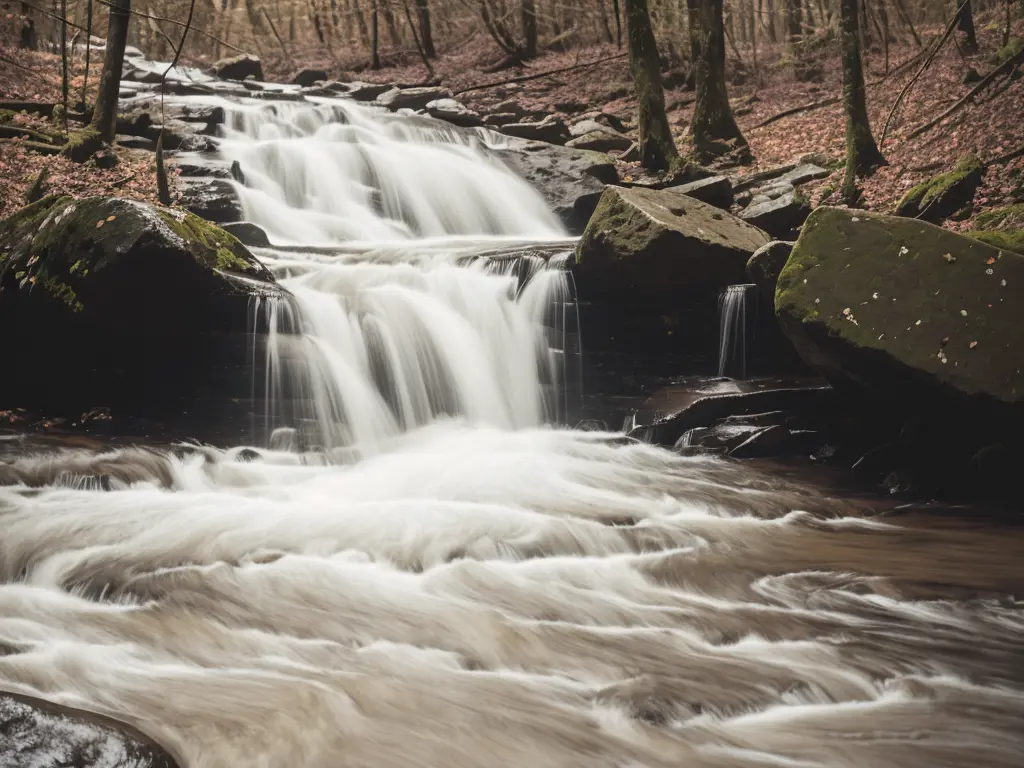
Muscatatuck Falls is best seen after rainfall, when the water gains volume and speed. Visitors walk alongside the river on forested trails where sycamores, ash, and maple trees rise overhead. Birdsong is constant, and the low rumble of the falls blends into the wider soundscape of the woods. It’s a place of motion, memory, and rooted calm.
16. Salamonie River Falls
The Salamonie River flows through a series of forested ridges before cutting into soft rock and forming several waterfalls, including the Salamonie River Falls—a collection of cascades more than a single dramatic drop. Located within the Salamonie River State Forest, this area is a favorite among hikers and anglers who value both scenery and solitude.
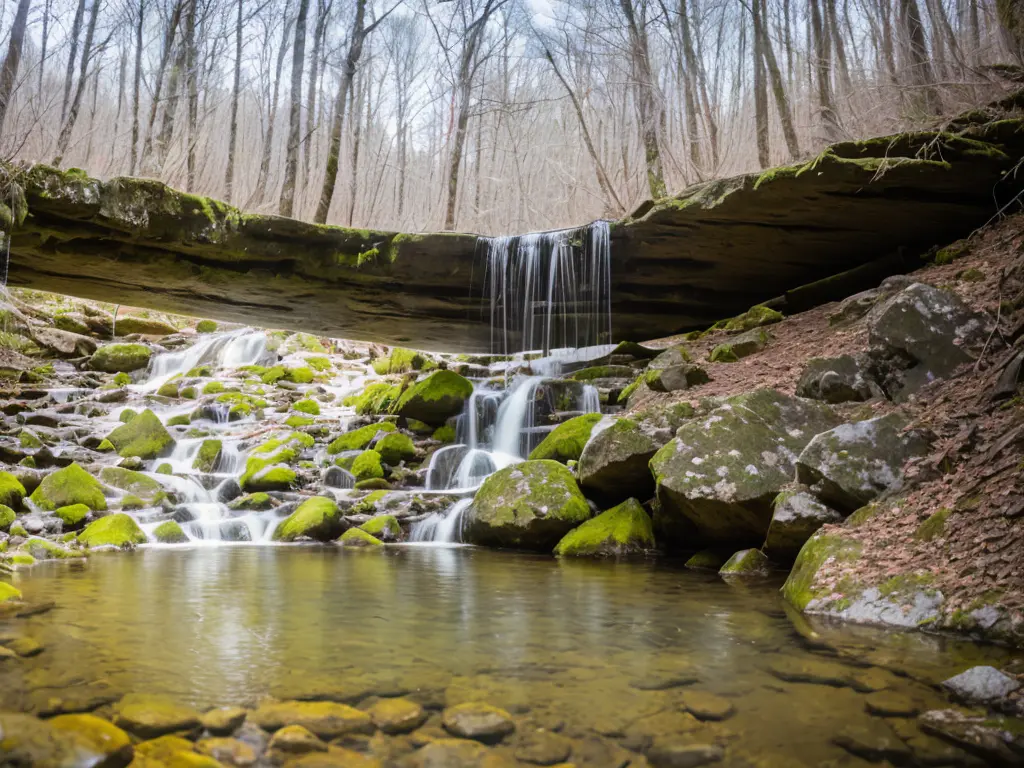
The geology here is mostly Mississippian sandstone and shale, shaped by water and freeze-thaw cycles over thousands of years. The river, dammed upstream to form Salamonie Lake, continues to cut its way through the terrain, leaving behind ledges and drop-offs where the water falls and pools. Depending on water levels, visitors might see anything from small trickling streams to more vigorous multi-level cascades.
Trails along the river offer elevated views of the falls and quiet picnic spots. Wildlife sightings are common—deer, hawks, and the occasional bald eagle glide overhead. In spring, the forest bursts into bloom, and the waterfalls become the centerpiece of a landscape in motion.
Salamonie River Falls offers a quieter kind of beauty—nothing staged, nothing showy, just the steady, continuous work of water shaping stone, season after season.
17. Silver Cascades
Silver Cascades lives up to its name, especially when sunlight strikes the water just right, turning each ripple into a shimmer of light. Found in Shades State Park, this waterfall is formed by a small creek slipping over ledges of sandstone and shale. While it’s not tall—often around 10 to 15 feet—it flows over multiple tiers, creating the effect of a staircase made of water and stone.
The rock here comes from the Borden Formation, laid down over 300 million years ago when the region was part of a massive river delta. Erosion has carved narrow ravines and sheer rock walls that feel more Appalachian than Midwestern. Silver Cascades sits deep within one of these gorges, accessible by trail and often framed by hanging moss, ferns, and spring wildflowers.
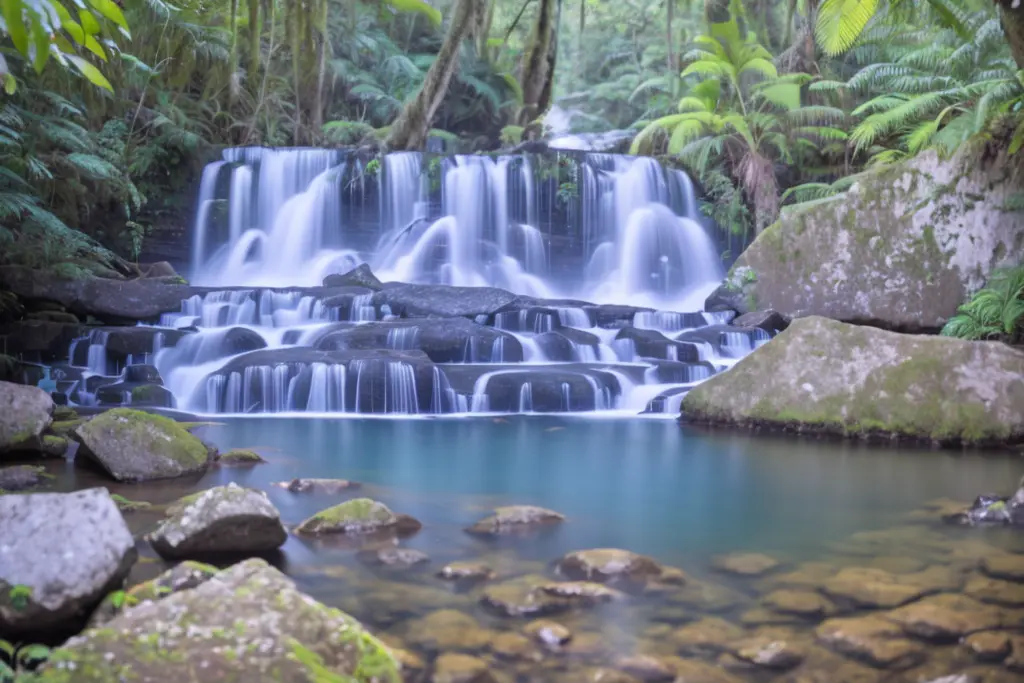
The name “Silver” isn’t just poetic. On a cloudy day, the falls appear gray and quiet, but when light hits at the right angle, the water takes on a bright gleam that looks metallic. It’s a moment of simple beauty—fleeting and real. Silver Cascades doesn’t roar; it whispers. And in its quiet motion, it reminds visitors why small things, given time, can leave a lasting mark.
18. Williamsport Falls
Williamsport Falls is Indiana’s tallest waterfall, with a drop of 90 feet from the edge of a sandstone cliff into a narrow gorge below. Located in the heart of Williamsport—a small town in Warren County—it’s one of the few urban waterfalls in the Midwest that maintains a natural feel. The falls are fed by Fall Creek, which flows strongest in the spring and after heavy rain. When conditions are right, the stream leaps from the ledge in a single sheet of water, creating a powerful vertical plunge.
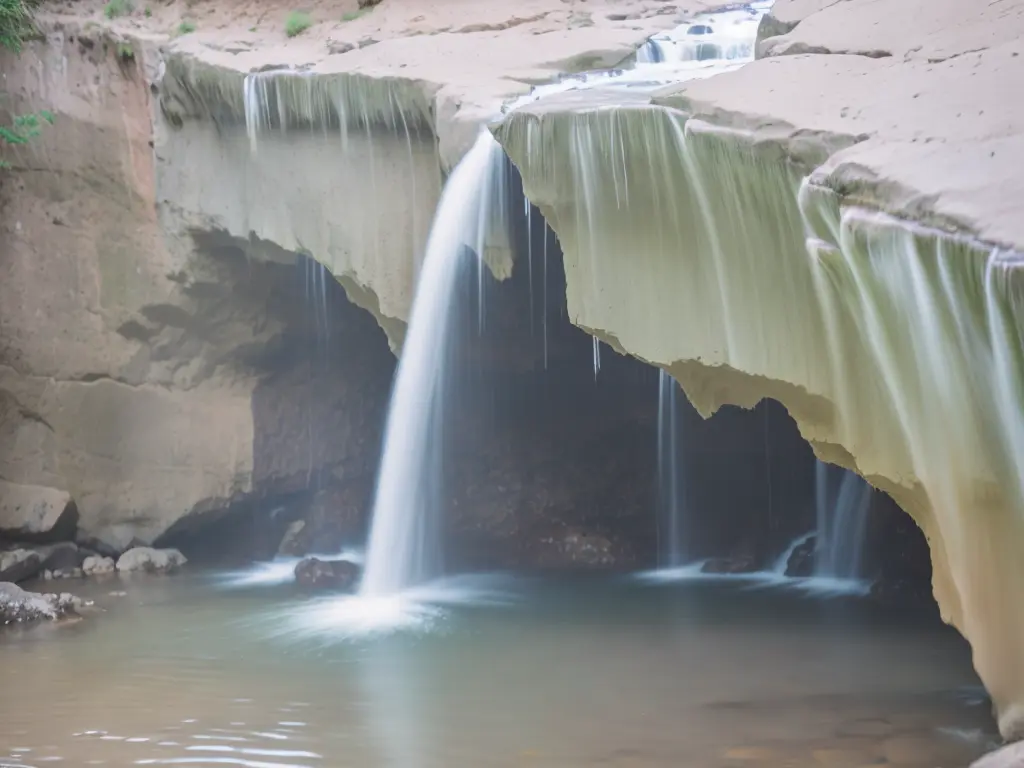
The rock behind the falls tells a long story. Formed during the Pennsylvanian period, it’s part of the same geological timeline as many of the state’s other falls. The cliff face shows signs of glacial shaping, erosion, and weathering—proof that this isn’t just the tallest, but also one of the oldest landmarks in the area.
Though it sits near roads and buildings, the falls remain wild at their base. Trails lead down to the gorge, where mist clings to the rocks and moss softens the hard lines of stone. The echo of falling water can be heard through town when the creek runs high.
19. Kokiwanee Falls
Kokiwanee Falls is one of the most scenic spots in northern Indiana, located within a 140-acre preserve along the Salamonie River. This waterfall pours over a sandstone ledge, typically dropping around 25 feet into a shaded gorge. The surrounding forest is rich in beech, oak, and maple trees, creating a canopy that cools the air and fills the area with filtered light.
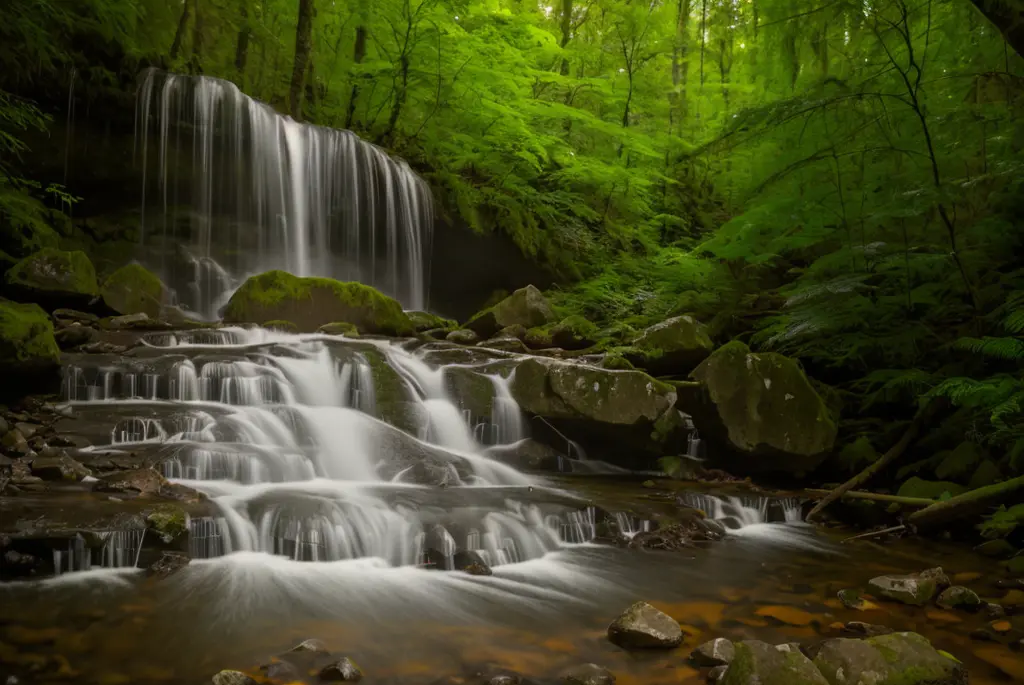
The preserve is managed by ACRES Land Trust and is named “Kokiwanee” after a Native American term meaning “place of the wild cat.” The land has long been valued for its biodiversity and dramatic topography. Trails wind through ridges and along cliffs, and as hikers approach the falls, the sound of moving water builds slowly before revealing itself at a bend in the path.
Kokiwanee Falls changes character with the seasons—forceful in spring, quiet and glistening in autumn. Its sandstone ledges are part of a much older geological story, shaped by the river’s steady erosion over millennia. Fossils occasionally appear along the trailside rocks, marking the age of the formations. For visitors, it offers an unforgettable moment where sound, motion, and stillness meet.
20. Thistlewaite Falls
Thistlewaite Falls is a hidden treasure near Richmond, Indiana, combining natural beauty with early industrial history. The falls are man-made, created in the early 1800s by Timothy Thistlethwaite, a mill owner who diverted the flow of the East Fork of the Whitewater River to power his sawmill. Despite its human origins, the waterfall has blended into the landscape over the centuries and now feels fully part of the surrounding nature.
The waterfall drops about 15 feet over a layered limestone ledge. The rock formations around the falls date back over 400 million years to the Silurian period, and fossil hunters often visit the site to find ancient marine fossils such as brachiopods, crinoids, and horn corals embedded in the streambed. The area is also popular for hiking, photography, and picnicking, with a short trail leading to a viewing area and natural stone platforms for exploring the water’s edge.
Thistlewaite Falls sits just minutes from downtown Richmond, offering easy access while preserving a sense of seclusion. It’s a favorite for locals and a surprise to many visitors who don’t expect to find such a peaceful, geologically rich waterfall tucked so close to town. It’s where history, science, and scenery quietly meet.
Conclusion
Indiana’s waterfalls are more than scenic backdrops, they’re time capsules carved by patience, pressure, and water’s quiet strength. From high cliffside plunges to soft, moss-lined trickles, each fall holds a story millions of years in the making. These aren’t the towering cascades of the Rockies or the tropical torrents of the Caribbean. They’re Midwestern in spirit: steady, understated, shaped by ancient seas and Ice Age runoff, and still flowing through forests and gorges that remain mostly untouched.
Visiting these sites is like stepping into a deeper layer of Indiana, one few people know exists. Beneath farmland and freeways, the state holds ravines laced with fossils, creek beds echoing with birdcalls, and stones that still bear the imprint of trilobites and coral reefs. You don't just see these places—you feel the weight of their age, and the calm they’ve gathered over generations.





